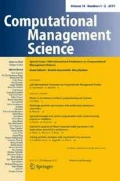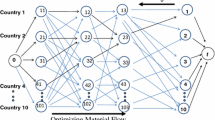Abstract
In this paper, we develop a competitive supply chain network model with multiple firms, each of which produces a differentiated product by brand and weights the emissions that it generates through its supply chain network activities in an individual way. The supply chain network activities of production, transport and distribution, and storage have associated with them distinct capacities and the firms seek to determine their optimal product flows and frequencies of operation so that their utilities are maximized where the utilities consist of profits and weighted emissions. Multiple production, storage, and transport mode options are allowed. The governing equilibrium concept is that of Cournot–Nash equilibrium. We provide both path and link flow variational inequality formulations of the equilibrium conditions and then propose an algorithm, which, at each iteration, yields closed form expressions for the underlying variables. Numerical examples illustrate the generality of the model and the information provided to managerial decision-makers and policy-makers. This paper adds to the growing literature on sustainable supply chains through the development of a computable general competitive supply chain network game theory model, which brings a greater realism to the evaluation of profit and emission trade-offs through the incorporation of frequencies.



Similar content being viewed by others
References
Aronsson H, Huge-Brodin M (2006) The environmental impact of changing logistics structures. Int J Logist Manag 17(3):394–415
Arvidsson N (2013) The milk run revisited: a load factor paradox with economic and environmental implications for urban freight transport. Transp Res A 51:56–62
Beamon B (1999) Designing the green supply chain. Logist Inf Manag 12:332–342
Bertsekas DP, Tsitsiklis JN (1989) Parallel and distributed computation: numerical methods. Prentice Hall, Englewood Cliffs
Boone T, Jayaraman V, Ganeshan R (eds) (2012) Sustainable supply chains: models, methods and public policy implications. Springer, London
Commission for Environmental Cooperation (2011) Destination sustainability: reducing greenhouse gas emissions from freight transportation in North America. Commission for Environmental Cooperation, Montreal
Corbett CJ, Kleindorfer PR (2003) Environmental management and operations management: introduction to the third special issue. Prod Oper Manag 12:287–289
Cournot AA (1838) Researches into the mathematical principles of the theory of wealth. MacMillan, London. English Translation 1897
Cullinane K, Khanna M (2008) Economies of scale in large containerships: optimal size and geographical implications. J Transp Geogr 8:181–195
Dablanc L (2007) Goods transport in large European cities: difficult to organize, difficult to modernize. Transp Res A 41:280–285
Dafermos S, Nagurney A (1987) Oligopolistic and competitive behavior of spatially separated markets. Reg Sci Urban Econ 17:245–254
Dupuis P, Nagurney A (1993) Dynamical systems and variational inequalities. Ann Oper Res 44:9–42
Environmental Leader (2012) H &M sustainability report: CO2 emissions drop 5% in 2011, April 13
EUROSTAT (2012) Energy, transport and environment indicators. Eurostat Pocketb. doi:10.2785/19616
Feldman SJ, Soyka PA, Ameer PG (1997) Does improving a firm’s environmental management system and environmental performance result in a higher stock price? J Invest 6:87–97
Floden J (2007) Modelling intermodal freight transport: the potential of combined transport in Sweden. BAS Publisher, PhD Dissertation. ISBN 91-7246-252-6
Gabay D, Moulin H (1980) On the uniqueness and stability of Nash equilibria in noncooperative games. In: Bensoussan A, Kleindorfer P, Tapiero CS (eds) Applied stochastic control of econometrics and management science. North-Holland, Amsterdam, pp 271–294
Hadhazy A (2009) How the manufacturing sector can curtail its greenhouse gas emissions. Pop Mech. http://www.popularmechanics.com/science/environment/climate-change/4340042
ICA (2008) ICAs nya distributionsnat effektivare distribution och minskad miljobelastning (ICAs new distribution network more efficient distribution and less environmental impact). Stockholm, Sweden
Intergovernmental Panel on Climate Change (1996) IPCC Guidelines for National Greenhouse Gas Inventories, Revised 1996. Switzerland, Geneva
Klassen RD, McLaughlin CP (1996) The impact of environmental management on firm performance. Manag Sci 42:1199–1214
Klein B, Leffler KB (1981) The role of market forces in assuring contractual performance. J Polit Econ 89:615–641
Kleindorfer PR, Singhal K, van Wassenhove LN (2005) Sustainable operations management. Prod Oper Manag 14:482–492
Linton JD, Klassen R, Jayaraman V (2007) Sustainable supply chains: an introduction. J Oper Manag 25:1075–1082
Nagurney A (1999a) Sustainable transportation networks. Edward Elgar Publishing, Cheltenham
Nagurney A (1999b) Network economics: a variational inequality approach, 2nd and revised edn. Kluwer Academic Publishers, Dordrecht
Nagurney A (2010) Supply chain network design under profit maximization and oligopolistic competition. Transp Res E 46:281–294
Nagurney A (2013) Designing sustainable supply chains for sustainable cities. Environ Plan B. doi:10.1068/b39039
Nagurney A, Dupuis P, Zhang D (1994) A dynamical systems approach for network oligopolies and variational inequalities. Ann Reg Sci 28:263–283
Nagurney A, Li D (2013) A dynamic network oligopoly model with transportation costs, product differentiation, and quality competition. Comput Econ. doi:10.1007/s10614-013-9387-6
Nagurney A, Liu Z, Woolley T (2007) Sustainable supply chain networks and transportation. Int J Sustain Transp 1:29–51
Nagurney A, Masoumi AH, Yu M (2012) Supply chain network operations management of a blood banking system with cost and risk minimization. Comput Manag Sci 9(2):205–231
Nagurney A, Nagurney LS (2011) Sustainable supply chain network design: a multicriteria perspective. Int J Sustain Eng 3:189–197
Nagurney A, Nagurney LS (2012) Medical nuclear supply chain design: a tractable network model and computational approach. Int J Prod Econ 140(2):865–874
Nagurney A, Toyasaki F (2005) Reverse supply chain management and electronic waste recycling: a multitiered network equilibrium framework for e-cycling. Transp Res E 41:1–28
Nagurney A, Woolley T (2010) Environmental and cost synergy in supply chain network integration in mergers and acquisitions. In: Ehrgott M, Naujoks B, Stewart T, Wallenius J (eds) Sustainable energy and transportation systems, proceedings of the 19th international conference on multiple criteria decision making. Lecture notes in economics and mathematical systems, Springer, Berlin, pp 51–78
Nagurney A, Yu M (2012) Sustainable fashion supply chain management under oligopolistic competition and brand differentiation. Int J Prod Econ 135:532–540
Nagurney A, Yu M, Masoumi AH, Nagurney LS (2013) Networks against time: supply chain analytics for perishable products. Springer Business + Science Media, New York
Nagurney A, Zhang D (1996) Projected dynamical systems and variational inequalities with applications. Kluwer Academic Publishers, Norwell
Nash JF (1950) Equilibrium points in n-person games. Proc Natl Acad Sci USA 36:48–49
Nash JF (1951) Noncooperative games. Ann Math 54:286–298
Roper Starch Worldwide Inc. (1997) Green gauge report. New York
Sarkis J (2003) A strategic decision framework for green supply chain management. J Clean Prod 11: 397–409
Seuring S, Muller M (2008) From a literature review to a conceptual framework for sustainable supply chain management. J Clean Prod 16:1699–1710
Sheu J-B, Chou Y-H, Hu C-C (2005) An integrated logistics operational model for green-supply chain management. Transp Res E 41:287–313
Trudell C (2013) Ford CFO’s sustainability call emphasizes greener profit. Bloomberg News
VTI (2008) The effects of long and heavy trucks on the transport system. Report on a government assignment, VTI rapport 605, Linkoping, Sweden
Waters H (2013) Supply chains of the future: sustainable logistics and profitability go together. Guardian
World Health Organization (2006) Health risks of particulate matter from long-range transboundary air pollution. World Health Organization, Copenhagen
World Health Organization (2013) Health effects of particulate matter. World Health Organization, Copenhagen
Yu M, Nagurney A (2013) Competitive food supply chain networks with application to fresh produce. Eur J Oper Res 224(2):273–282
Acknowledgments
The first author acknowledges support from the School of Business, Economics and Law at the University of Gothenburg through its Visiting Professor Programme. The authors are grateful to the two anonymous reviewers and to the Guest Editors for helpful comments and suggestions on an earlier version of this paper.
Author information
Authors and Affiliations
Corresponding author
Rights and permissions
About this article
Cite this article
Nagurney, A., Yu, M. & Floden, J. Supply chain network sustainability under competition and frequencies of activities from production to distribution. Comput Manag Sci 10, 397–422 (2013). https://doi.org/10.1007/s10287-013-0190-6
Received:
Accepted:
Published:
Issue Date:
DOI: https://doi.org/10.1007/s10287-013-0190-6




